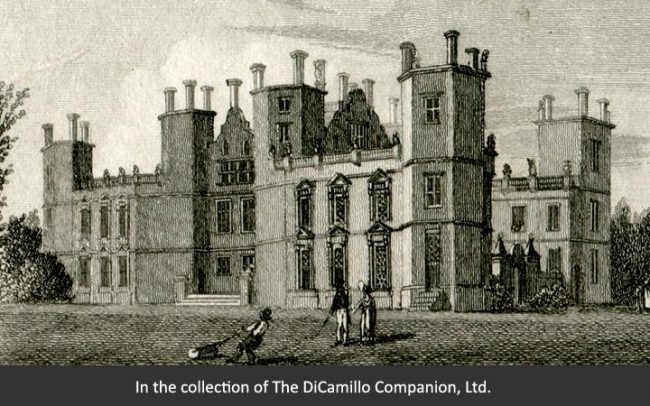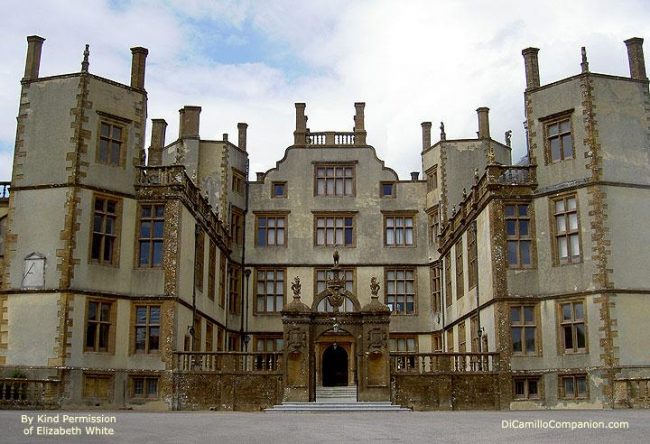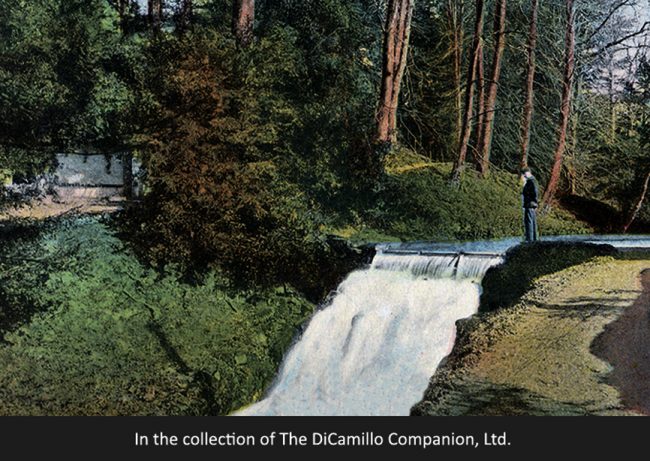
A circa 1825 image of the house from "Marshall's Select Views of Great Britain"


The waterfall from a 1916 postcard
Built / Designed For: Sir Walter Raleigh
House & Family History: More stately home than fortified castle, Sherborne was built by Sir Walter Raleigh beginning in 1594. The story goes that Raleigh was journeying to Plymouth when he saw the Sherborne Estate, which was then only a 12th century hunting lodge in a deer park owned by the Church of England. Raleigh admired Sherborne so much that Queen Elizabeth I "persuaded" the church to grant the Estate to the crown on a 99-year lease, which she promptly made over to her favorite, Raleigh. Raleigh built a new house around the core of the old hunting lodge (today the Old Castle) that he called Sherborne Lodge. Although Raleigh lived here for only a decade, one amusing tale of his time at Sherborne has survived. It seems that, as Raleigh sat and looked out over his gardens to the Dorchester road, he lit his pipe. A servant, not familiar with this new habit of smoking, thought that his master was on fire and threw a glass of ale over him! After Raleigh's execution in 1616 Sherborne was purchased by the Digby family, whose descendants have owned it ever since. The Digbys wasted little time in putting their own stamp upon Sherborne. In the 1620s they added four wings to Raleigh's simple rectangular house. Shortly after, Sherborne saw action in the Civil War, when Parliamentary troops reduced the Old Castle to rubble. It is only at this point that the name Sherborne Castle came to be used to describe the house that Raleigh and the Digbys had built. The house has entertained royalty on more than one occasion; Prince William of Orange stayed here in 1688, and George III in 1789. The interior of Sherborne Castle is replete with family portraits, fine art, furniture, and porcelain collected by the Digby family over their centuries of residence here. The ceilings show off excellent Jacobean plasterwork, but even more intriguing are the original kitchens, built by Raleigh. The Great Hall and the dining room at Hillbark, Merseyside, are lined with Jacobean paneling that is said to have come from Sherborne. (This history kindly provided by Britain Express.)
Garden & Outbuildings: Benjamin Bastard designed the stables, which were built in 1759. By the 18th century the house was surrounded by 20 acres of landscaped gardens and a 50-acre lake designed by Capability Brown. On the verge of the lake are huge cedar trees that are over 250 years old. Alexander Pope wrote fondly of the gardens of Sherborne.
Architect: Lancelot Brown
Date: 18th centuryJohn Preston (J.P.) Neale, published under the title of Views of the Seats of Noblemen and Gentlemen in England, Wales, Scotland, and Ireland, among other titles: 2.S. Vol. IV, 1828.
Country Life: XXVIII, 425, 1910.
Title: Biographical Dictionary of British Architects, 1600-1840, A - SOFTBACK
Author: Colvin, Howard
Year Published: 1995
Publisher: New Haven: Yale University Press
ISBN: 0300072074
Book Type: Softback
House Listed: Grade I
Park Listed: Grade I
Current Seat / Home of: John Wingfield-Digby; Digby family here since 1617.
Past Seat / Home of: Sir Walter Raleigh, until 1618. John Digby, 1st Earl of Bristol, until 1653; George Digby, 2nd Earl of Bristol, 1653-77; John Digby, 3rd Earl of Bristol, 1677-98; G.D. Wingfield-Digby, 19th century.
Current Ownership Type: Individual / Family Trust
Primary Current Ownership Use: Private Home
House Open to Public: Yes
Phone: 01935-813-182
Fax: 01935-816-727
Email: [email protected]
Website: https://www.sherbornecastle.com/
Historic Houses Member: Yes